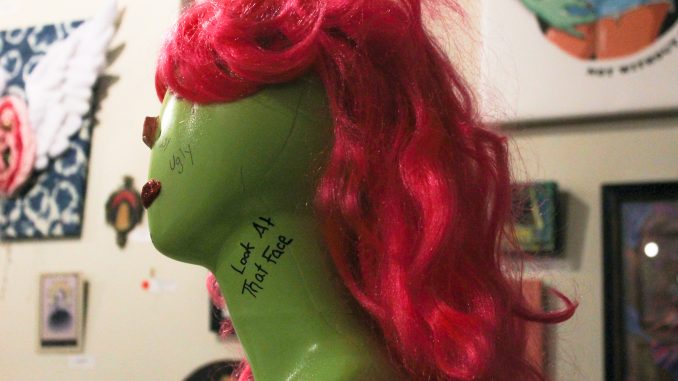
Tamara Torres knows how art can unite women.
It began six years ago: Torres was working in downtown Trenton, New Jersey when she walked into a clothing store during her lunch break. Fascinated by the Arabic hip-hop music playing inside, she met the owners: two immigrant women who were saving money to bring their daughters to the United States.
Touched by their story, she created “Freedom,” a photograph featuring a wide-eyed girl with tape fastened over her mouth. Their reaction to the picture, Torres remembers, was tearful and appreciative.
“And I said, ‘I hope that your daughters see a bigger world, and I hope they eventually can rip that tape off their mouth,’” Torres said.
In another effort to bring women together in solidarity, one of Torres’ latest works currently hangs over the entrance to “Nasty Women: A Group Exhibition,” at the newly opened ABD Photography & Gallery near 11th and Carlton streets.
During the opening reception on Jan. 6, the tiny space overflowed with visitors and work from more than 70 artists. Each piece focused on women’s issues in some way, ranging from body image to reproductive health. The exhibit will end on Jan. 31.
Torres, a survivor of childhood homelessness and sexual abuse, has been using photography as an outlet since she was a teenager. “Freedom” was the first of many political pieces. As the photograph headed to a UNICEF exhibit in Italy, Torres began to travel with her art, observing the struggles women shared worldwide.
“We’re all trying to, somehow, put our foot down on the ground,” Torres said.
Torres’ collage in the exhibit includes a policeman — a reminder, she said, of ongoing police brutality — as well as an image of a white woman, reminiscent of the 1950s, accented with the word “privileged.” “Poderosa,” the feminine Spanish expression for powerful, graces the work as Torres’ nod to the immigrant community.
“I think that this whole election has been a wake-up call that kind of pushed me to try to be more active politically, because that’s the only way that we can see some change,” said Lillian Ham, a junior psychology student who has artwork shown at the gallery.
While Ham’s work has not always been politically charged, that changed when she created the painting “Murdering the Modern Woman.” The piece displays figure drawings of a woman’s head, body and pair of hands, making a statement on women’s healthcare, Ham said. The day before the exhibit opened, Speaker of the House Paul Ryan said the GOP would work to take away Planned Parenthood’s federal funding.
“People are actively trying to control the reproductive rights of women, trying to defund Planned Parenthood,” Ham said. “It was kind of upsetting to me that the voices of women who were protesting and who these policies were directly affecting were not being heard.”
Iridescent gold paint poured from the mouth and eyes of the head in Ham’s painting as a representation, Ham said, of women protesting, organizing and dissenting.
For Christy O’Connor and Andrea D’Alessandro, the curators of the exhibit, the goal was empowerment.
“Women are generally underrepresented in the art industry to begin with, and the fact that we’ve pulled all these women in for this statement of this show I think is strong in itself,” O’Connor said.
“So it’s not only a self-empowering thing, but it’s also like empowering women to band together too and show their strength in numbers,” she added.
A mannequin stood in the center of the gallery draped in a bubblegum-pink wig and a coat of lime green paint. A pair of headphones dangled from one of its shiny hands, offering listeners a loop of phrases that President-elect Donald Trump has directed at women.
“You can do anything … grab them by the pussy,” Trump’s voice crackled through the headphones.
O’Connor, the artist behind the mannequin, said her work doesn’t usually get political.
That changed three months ago during the final presidential debate in October.
When Trump referred to his opponent Hillary Clinton as a “nasty woman,” O’Connor’s first instinct was to write a Facebook rant. Instead, she created an open art call for fellow female artists that evolved into the current exhibition.
“I hope when people go up to that show, they feel all those emotions and they feel inspired to actually take a stand,” Torres said. “If it’s women, I hope they come out of there feeling like they’re not alone.”
Angela Gervasi can be reached at angela.gervasi@temple.edu or on Twitter @AngGervasi.


Be the first to comment